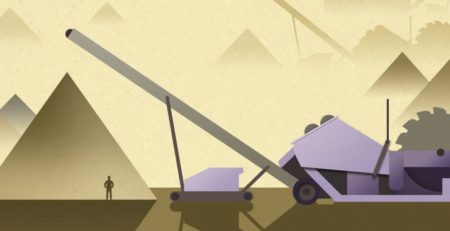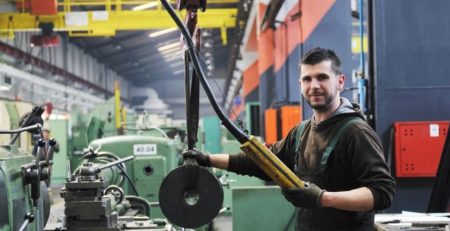Improve your processes instantly!
Is it possible to increase efficiency, safety and quality, reduce costs and shorten production time without months of planning, trials and testing, endless meetings and presentations? Could these changes be permanent? Do we need experts to implement them? The Japanese concept of Lean Manufacturing assumes that the most important thing is to solve problems at the source, using the intellectual potential of the employees.
There’s no shortage of problems in our daily work. From morning to evening, employees and their supervisors struggle away laboriously with emerging obstacles. The vast majority of these problems are repeated, and after months and years of work we perceive ourselves as being experts in solving them. And this is true. No one can ‘put out the fire’ in our domain as quickly as we can, for example:
- Replace the bearings in a clinker cooler fan,
- Refill the linings in a ball mill,
- Take control of deregulated parameters of a clinker furnace and reorganise a shipment of cement, etc.
From time to time we wonder whether it wouldn’t be worth being proactive and undertaking activities that would eliminate certain persistent problems.
Then, we spend months or even years performing a number of examinations, we have meetings, we present the results and prepare a budget. Next, we wait patiently until the moment comes when the budget is approved by the investment department, and finally, after subsequent months of implementation we can enjoy:
- A new silo,
- Modern drive and measuring equipment,
- New colleagues,
- Larger and more powerful devices, squares, halls, machines etc.
The effect is clearly visible. Productivity has increased and problems arise less frequently.
However, why not try working in a slightly different way? Lean proposes a tool called Kaizen Workshops (or Kaizen Blitz, Kaizen Event or simply Kaizen). Kaizen is a Japanese term for continuous improvement. Blitz is a German word meaning a lightning, bolt. Their purpose is to immediately improve the process.
Kaizen Workshop characteristics:
- Workshop duration and schedule,
- Focusing on a particular outcome,
- Diversified composition of the project team,
- Support and oversight of the board.
An entire Kaizen project is completed in 5 working days. The participants dedicate 100% of their time to achieving the intended aim. Work begins in the morning and continues until the plan of the day is completed. As such, participants should be prepared to work over 8 hours.
Five days is the time in which a non-investment solution to a problem should be found. This time causes positive pressure, and forces a focus on the given work. We don’t pay attention to other things that are common in our everyday work, so at the end of the day we think, ‘Gosh, the day has passed and I haven’t done anything’.
However, a tight schedule doesn’t mean a ‘fast aspiration for solutions’. On the contrary, Lean just puts the emphasis on the right direction. This means that we dedicate sufficient time to exploring the subject of Lean. We spend all of Day 1 of the workshop on it, exploring the Lean philosophy, and searching for the 8 types of waste: overproduction, excessive inventory, errors and quality defects, waiting, over-processing, unnecessary transport, unnecessary movement, and unused employee potential. In practice, if our problem is, for example, the performance of a cement mill, we don’t focus on it having a weak engine, a too-small mill or other technical parameters when searching for reasons. Instead, we look for reasons why value-added is not appearing. For example, the milling time is greater than it should be for the technology used; the working time of the mill is shorter than necessary; the worker is performing complex operations while the mill is being handled, or maybe there is a lack of visual parameters. We spend the whole day in gemba. During this day we don’t think about solutions. We observe the process with humility and search for waste!
The quality and number of our observations is very important. The minimum number of problems spotted on that day and by each of the participants is a hundred. Yes, exactly. A hundred. It is possible to successfully find this number of obstacles in every production process. We look at the milling area, and we’re searching and taking notes.
If necessary, we focus on process observation on the following day too. That is the essence of Lean: approaching the problem with humility, not to generate solutions without first getting to the cause. Let’s leave the obvious and demanding investment solutions for others and for another day. We’re interested in root causes and root solutions. Thus, it’s not the new bag palletizer, but too-tightly sealed or leaky air ducts. It’s not an additional production change but the ergonomic situation of the workers, who can’t focus on the control process while working in unsuitable shoes and masks.
The third day is about getting to the root causes and developing countermeasures.
Attention! We don’t locate the causes through analysis of documents, interviews with managers and workers or based on reviews. Instead we test, check and touch. We personally enter the mill to check the facts of our interest, even if we have an opinion of the Maintenance Manager. If the given test does not confirm our assumptions, we don’t give up – this is also a success – as we then know that the proposed solution is no good…. so we perform another test.
Day 4 is spent on implementing solutions. This day is the quintessence and greatest power of the Kaizen Workshop process. Each workshop has its assigned Senior Manager – a member of the company board, or at least the Plant Manager. Every day at the same time, the Senior Manager meets the project team. He or she also approves the purpose of the Workshops and offers help and his/her decisiveness. The Senior Manager also informs the company/plant that the Kaizen Workshops have priority, so that the team can undertake any action and the appropriate means will be made available.
In practice, this means that if the team decides that to solve the root cause of a problem it is necessary to perform production tests, they are executed. If it is necessary to change the driving organisation at the loading site, the change is made. If it’s necessary to move a machine, it is moved. If it’s necessary to provide the workers with magnetised torches to keep their hands free – the torches are immediately bought (someone simply gets in a car and goes to the store). We act! We’re not afraid of failure. If an idea proves to be a dud, we draw conclusions and implement modifications, etc. And this is still an advantage for us, as both we and the company have learnt something in the process.
Day 5 is the time for summarising and presentations, at which the assigned board member is present, preferably even the president of the company. Since the Kaizen workshops have a clearly-defined purpose, their assessment is of a binary nature: either we achieved a performance boost of 3%, or not; the number of damaged bags decreased by 2%, or it didn’t. Specifically. A 30-day plan is also developed for the actions that still need to be taken to make the effects of the workshop optimal and persistent.
The team – this is the second pillar of the Kaizen Workshop’s uniqueness, as it is composed of individuals with a specific profile and responsibility: Leader, Co-leader, Fresh look – 2 persons, Operator – 2 persons, Constructor, A person from processes up and down the value stream – 2 persons.
As we can see, the team is highly diversified. Let’s pay special attention to some of those team members who are not participating in solving problems in a particular area of a traditional business:
- The leader – Lean requires the leader to be from outside the improved area. This means that while working on the performance of the mills (for example), the leader of the team cannot be assigned from the mill/grinding plant – neither managers nor workers. This ensures that the fundamental mistake is avoided: starting and conducting workshops in a specific direction. The area manager or workers have been working there for many years, thus have baked-in convictions about what should be done to improve the performance of the mill. Kaizen workshops are about new solutions, not confirming current beliefs.
- A person from the processes up and down the value stream – Namely, someone from the hall/process just before and just after the process/area to be improved. For example, for the mills it would be a representative from the packaging/storage department, or the clinker production department. Unfortunately, many improvement projects and initiatives are carried out without taking into account their impact on adjacent departments. And sometimes, a great success for one department becomes a problem for the others. But the presence of a representative from a neighbouring department can prevent such situations.
- Fresh look – There should also be people who are absolutely not connected with the process/area under improvement. They should preferably be from the offices – accounting, logistics, human resources, marketing, etc. These people look at the process from a completely new perspective. Their sometimes seemingly naive questions can often lead to breakthrough results, and even abandonment of a number of original activities.
- Operator – As the worker directly overseeing the process, the ‘operator’ is considered in Lean to be the most valuable asset a company has. This person is only not only able to immediately try out the solutions, but often protects the team against implementation of solutions that seem brilliant ‘from behind a desk’.
An important person is also Kaizen Coach – usually someone from outside the organization, which as an expert ensures that the workshop and solutions are developed in the spirit of Lean.
I had the opportunity to lead and participate in many Kaizen Workshops, the effects of which were truly ground-breaking for the company involved. The workshops are also a great tool for team building. After five days of fighting with a problem, with many ups and downs, there will often be tears and nostalgia that the end of the adventure is near. Gathering a group of willing people and focusing on teamwork and hard work in order to find the root causes of a problem, can solve a problem that may previously have been thought about for years.
Even if we’re full of concerns about whether such workshops could succeed at our place – let’s take the risk! The worst that can happen is that after five days we have enormous, new knowledge about a process. However, the most probable result will be that we achieve great success.
During the Kaizen workshops, we’re guided by the following principles:
- Leave all titles and positions at the door,
- Treat others as you would like to be treated,
- Improvement requires change. Don’t waste time justifying the current situation,
- Perform activities based on facts, not emotions or impressions,
- Just do it. Here and now!














Leave a Reply